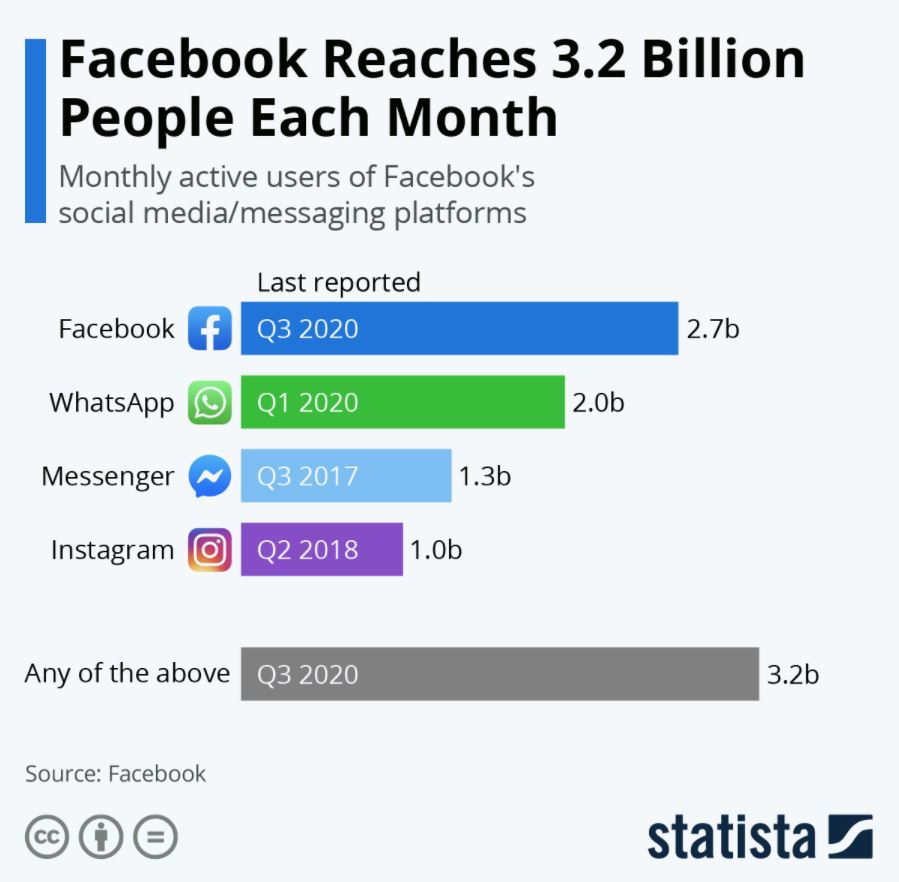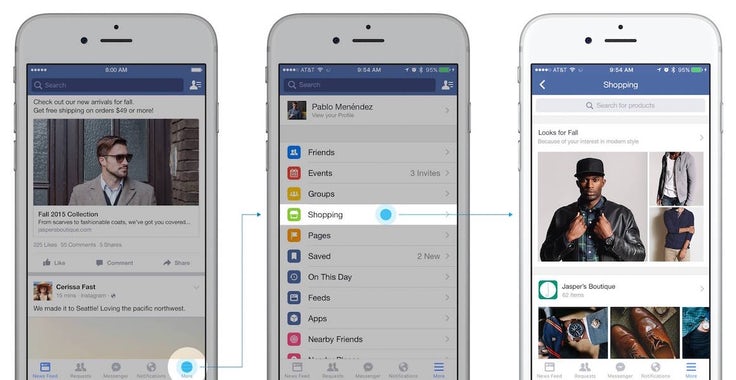Table of Contents
- How to Optimize Your Facebook Catalog
- How to Set Up for Result Tracking
- How to Create a Successful Facebook ecommerce Marketing Strategy
- Get Ready to Increase Reach and Conversions with Facebook Shops
When it comes to Facebook marketing, you can use almost all types of Facebook ads to market your products, whether you are highlighting individual products in a video awareness or traffic objective campaign, or creating a carousel for catalog sales objectives.
Although Facebook has become a standard advertising and marketing channel for retailers, its development as an e-commerce platform is still in its early stages. But the company is testing new ways to get people to buy on Facebook.
- Facebook has 2.80 billion monthly active users
- In 2020, Facebook had an annual growth rate of 57%
- Facebook is the largest social media platform based on the number of monthly active users
- On average, Facebook advertising generated $9.82 per user in Q4, 2020

This powerful PPC platform, when integrated with other channels such as Google Ads, email marketing, and overall customer experience, can greatly unlock your e-commerce potential.
This guide will take you through everything you need to create a successful Facebook e-commerce strategy, including managing your Facebook catalog and setting it up for proper tracking, the types of Facebook campaigns that must be included in your marketing strategy, and what you need. Use all content on Facebook and Instagram.
1. How to Optimize Your Facebook Catalog
Your catalog is an important part of Facebook e-commerce. Not only do you need it to handle important e-commerce Facebook activities (such as dynamic product ads), but you also need it to convert sales directly on Facebook and Instagram. Why? Because, as you probably know, any information passed to the Facebook product feed will be displayed in your ads and in the Facebook store. The following are some expert optimization and management tips.
1. Keep your Feeds Updated
Your Facebook product catalog should be up to date. If you use the Facebook pixel to update the product feed, this will happen automatically when you make changes to the store website. However, for those with a wider inventory, you need to do two things:
1. Set up scheduled data feed upload daily or hourly.
2. Use Catalog Batch API.
2. Integrate your best product photos
Make sure you include more than one high-quality product image to provide Facebook’s algorithm with more combination options to maximize results. You also want to make sure to use 500 x 500-pixel images specifically for Facebook feeds and swap out images that don’t meet Facebook’s specific product image specifications.
3. Optimize your product category
You should use catalog subsets to give you more control over the products that will be displayed in your store and e-commerce Facebook events. You can read more about it here.
In addition, because Facebook uses Google Merchant Center’s category and type taxonomy, you want to use the Google product category field. This helps ensure that you choose the correct product type or category to explain your product.
4. Optimize your product description and title specifically for Facebook
Whether it’s your website, Google or Facebook, you need to optimize your feed for the platform. For Facebook, this means making sure to exclude any newlines, special characters, or any unique content you use in your store.
Another important consideration when optimizing the Facebook product catalog is that you should remove brand names that may be included in the product name of your store. Facebook provides a separate product field for this and enables you to dynamically add it to the main headline and text for advertising purposes.
2. How to set up Result Tracking
Being able to accurately track your Facebook e-commerce results is critical to not only be able to optimize your activities but also your store area. As we all know, the Facebook pixel is not the best way to track the behavior of potential shoppers on your website after they leave Facebook.
To help fill in these data gaps, you need to use the Facebook pixel helper tool and the event data source section of the Facebook ad catalog manager. This will help you track the content_id match rate of items in the directory more consistently.
3. How to Create a Successful Facebook ecommerce Marketing Strategy
The same basic marketing rules apply to funnels when building a successful Facebook e-commerce strategy. In short, you need to create various marketing campaigns for different customer journey segments. You also need to test different strategies to find a successful combination that is specific to your brand, market, niche, and product. For example, you may find that dynamic product ads work much better when combined with retargeting. At the same time, carousels and videos with similar audiences can provide you with the best return on ad spend to attract new potential customers.
Below is a list of Facebook ecommerce must-have campaigns and some of our expert optimization tips for each event.
1. Use dynamic product ads for remarketing and conversion
The most important activity in the Facebook e-commerce library is dynamic product advertising, often called catalog sales activities.
Based on the potential customers’ previous behavior on your website, these ads will be combined with your product catalog to show specific products to potential customers who are interested in the products you sell. This will not only increase your click-through rate potential but also increase your conversions.
2. Use collection Ads to promote catalog sales
The next must-have activity you should test for Facebook e-commerce is collection ads. Compared with similar carousel ads, series ads provide more customization and personalization features. It is an automated ad that not only sells products in a highly visual manner, but also sells your brand.
3. Improve e-commerce brand exposure through strategic real-time experience advertising
Formerly known as Canvas advertising, instant experience advertising is another necessity for Facebook e-commerce. If you are not familiar with them yet, consider each Instant Experience ad as a lookbook of various types, where potential shoppers can watch product or brand videos, browse product carousels and view lifestyle product images-all All products are marked Experience in an advertisement.
4. Use Messenger ads to connect with potential shoppers
Another powerful Facebook e-commerce tool in the marketing toolbox is Messenger ads. In order to take advantage of these campaign types, you need to be very keenly positioned, use the power of chatbots to respond to comments and queries immediately, and focus on making a good first impression.
5. Use single image and video Facebook ads to attract new shoppers
Last but not least, without a standard single image or video ad, any Facebook e-commerce campaign strategy is incomplete. When you combine this format with strong brand stories, key events, promotional countdowns, and product launches, they can help you attract new potential shoppers to a large extent.

4. Get ready to increase reach and conversion rate through the Facebook Shops
Finally, it’s time to talk about Facebook and Instagram shops. Facebook Shops is different from Marketplace in that it allows sellers to create a Facebook store that can be accessed on the Facebook and Instagram platforms. Think of it as Facebook’s Google Shopping feed.
Creating a Facebook shop will not only provide you with an additional channel to sell your products, but in the next few months, brands will be able to tag products from their catalog or Facebook store before starting live video streaming.
Deepak Wadhwani has over 20 years experience in software/wireless technologies. He has worked with Fortune 500 companies including Intuit, ESRI, Qualcomm, Sprint, Verizon, Vodafone, Nortel, Microsoft and Oracle in over 60 countries. Deepak has worked on Internet marketing projects in San Diego, Los Angeles, Orange Country, Denver, Nashville, Kansas City, New York, San Francisco and Huntsville. Deepak has been a founder of technology Startups for one of the first Cityguides, yellow pages online and web based enterprise solutions. He is an internet marketing and technology expert & co-founder for a San Diego Internet marketing company.



